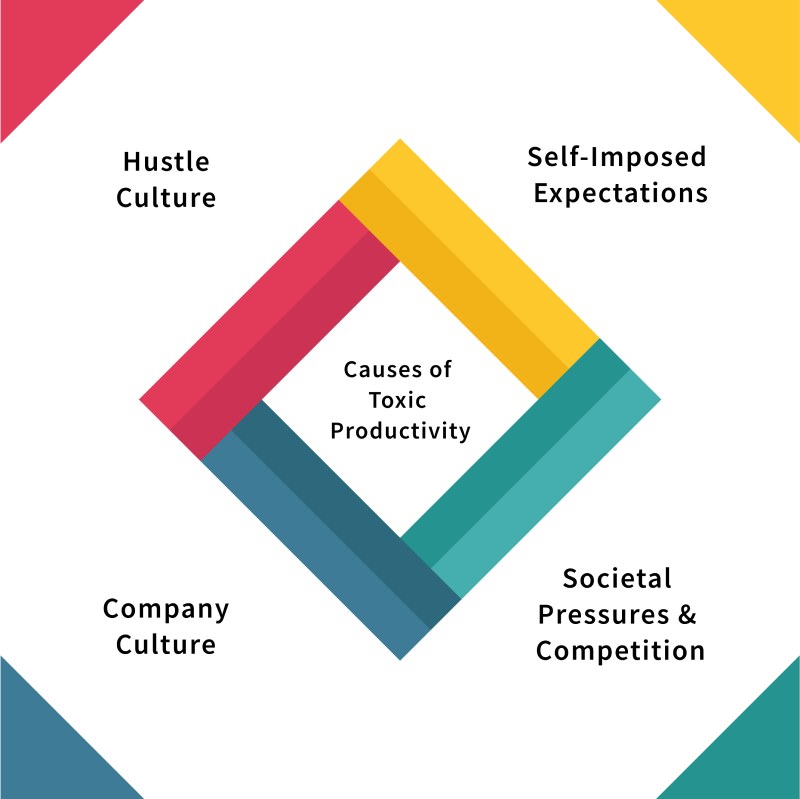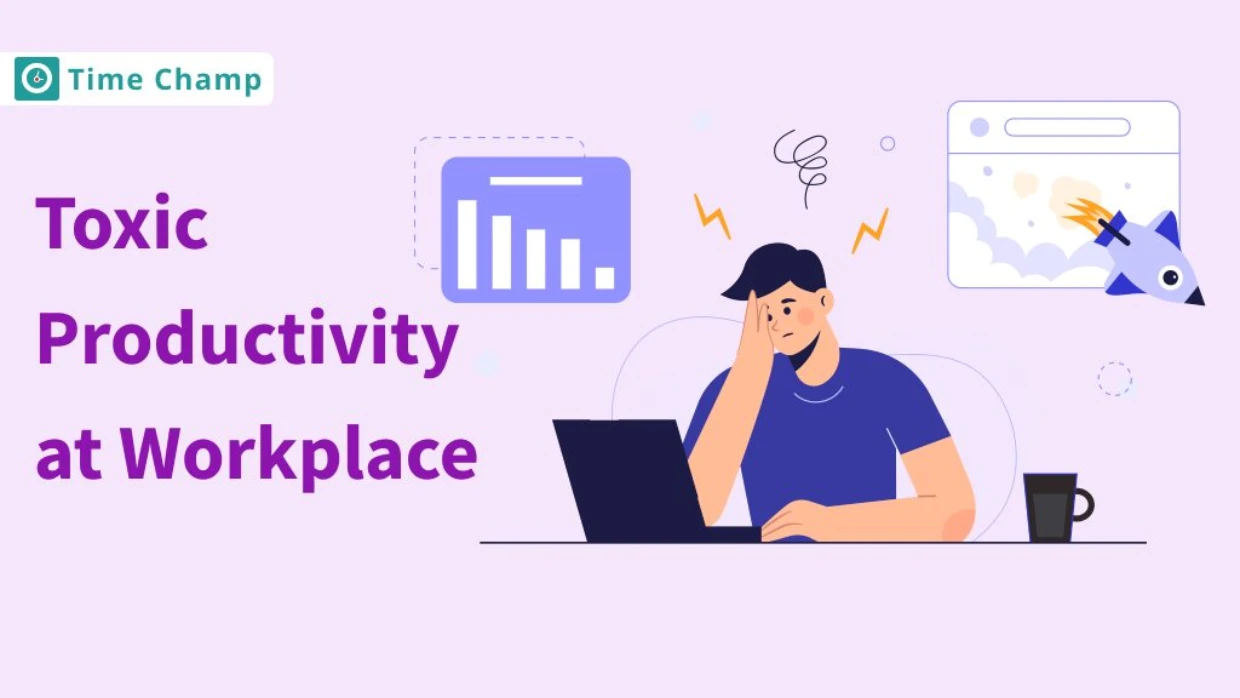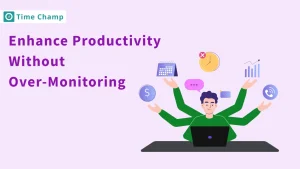Working harder can put your employees into a toxic cycle of productivity. This mindset drains energy, leads to burnout, and ultimately hurts long-term results. High performance can be challenging to balance with employee well-being, leading to disengaged and unmotivated teams. If you know what toxic productivity is in the workplace and how to overcome it, you can create a healthier environment where productivity is possible without sacrificing satisfaction.
In this article, you will explore the causes of toxic productivity, what are the consequences, and signs to find it early. And also share some effective strategies to break the cycle and promote sustainable performance at your workplace. Let’s dive in!
What is Toxic Productivity?
Toxic productivity is an unhealthy focus on being productive all the time, both at work and in life. It occurs when individuals constantly push themselves to achieve more, even if it harms their physical, mental, and emotional health. Unlike healthy productivity, toxic productivity doesn’t let employees take a rest or enjoy free time.
But it causes stress, burnout, and exhaustion. It can also damage relationships and disrupt employees’ work-life balance. And it can hurt individuals’ overall health. If you or your employees are feeling guilty for not working all the time, it might be time to check for toxic productivity. This early recognition allows you to create a healthier work environment centered around sustainable performance.
Signs of Toxic Productivity
Managers who want a healthy work environment need to recognize the signs of toxic productivity. If you notice these signs in your team, it’s time to take action to prevent hurting morale and productivity. If you can address these signs early, you can build a balanced workplace that supports employee well-being and everyone’s success.
1. Overworking
A very clear sign of toxic productivity is when employees overwork themselves. If you see team members staying late, skipping breaks, and working weekends, it’s a warning that something is wrong. More often, this comes out of the anxiety that is required to finish the impossible task when deadlines and expectations become unrealistic or tight.
Work Fatigue and lower effectiveness caused by overworking will ultimately break productivity. You might find that your employees are taking less vacation or not taking any leaves at all. As well, they may also fear falling behind or worry that others will notice their absence. Eventually, this constant pressure to work harder will lead to burnout and disengagement.
2. Feeling Guilty
Employees feel guilty when they take a break or leave work on time. A harmful work culture is one where employees are worried about not being available or if they are worried about being judged for not working long hours. This guilt can bring them to work day and night, even during their time, and will eventually worsen their total health.
You might see employees checking their emails or finishing tasks outside of regular working hours. This is often out of the belief that they will always need to be present to show their commitment. However, it can lead to an unhealthy work environment where employees feel they can’t fully disconnect from the work.
3. Prioritizing Quantity Over Quality in Tasks
Toxic productivity arises when employees prioritize doing tasks quickly over quality. They might also rush through assignments just to check the boxes rather than spend time and make sure of standards. This shift of focus can lead to mistakes and therefore poor outcomes which will eventually damage the overall team goals.
If employees are constantly complaining about their workload or that they need to work faster, that’s a sign of a pressure-driven environment. However, focusing on quantity leads to a lowering of morale since employees could feel their hard work isn’t appreciated.
4. Work-Life Balance
Lack of work-life balance is a major sign of toxic productivity. Full-time office workers should be able to make time for personal activities and family without suffering because of schedule demands in the workplace. In such cases, they may become stressed and may also not get satisfaction in their life as well as in their work.
Many employees continue to stay connected to work-related tasks beyond their work hours. This separation of work from personal time can lead to overwork that increases stress and consequently affects employees’ mental health into a cycle of overwork.
5. Experiencing Burnout Symptoms
Clear signs of a toxic environment include burnout symptoms such as chronic fatigue, irritability, and lack of enthusiasm. If employees feel overwhelmed or disengaged, you need to listen. The symptoms can result in lower performance and job dissatisfaction.
If employees take frequent sick days or appear unwell at work, it’s a sign of burnout. They are having too much work and these physical and emotional signs are telling you that they are struggling.
6. Chronic Anxiety or Depression
Chronic anxiety or depression in team members signals a toxic workplace. When employees often express worry, sadness, or hopelessness about work, it’s a clear warning sign. Focusing too much on productivity worsens these issues and makes it hard for them to do their best.
You may find employees pulling away from team interactions, or failing to feel excited when working on a project. This affects teamwork and productivity. Therefore, it is essential to adopt a healthier approach to productivity.
Causes of Toxic Productivity
You need to know the causes of toxic productivity to create a healthier work environment. However, several reasons lead to this hazardous condition from affecting the employees’ well-being to influencing the performance of the organization as a whole.

1. Hustle Culture
Hustle culture is a belief that being constantly busy and working long hours is the way to success. In this kind of environment, you might see that employees who stay late or take on extra work, often get more praise. But this glorification of overworking can turn into bad competition among the staff and result in burnout.
Harvard Business Review reported that 94% of workers feel pressured to work extra hours. In addition, 56% have trouble disconnecting from work after hours. It can also drain people physically and mentally. Gallup study showed almost 77% of employees are suffering from burnout, which causes a loss of productivity, and an increase in the turnover rate. You need to know these signs and promote a culture of rest and work-life balance.
2. Self-Imposed Expectations
Many employees have very high standards for themselves because they want to be recognized or they don’t want to fall behind. You may see that team members are willing to sacrifice their well-being to meet these high expectations. According to Joblist, 73% of workers feel anxious about their job performance and 67% admit to sacrificing personal time to do the work.
When employees cannot meet their expectations, they feel chronic stress and feelings of inadequacy. You can reduce this pressure by suggesting realistic goal setting and celebrating all achievements. Creating a supportive environment is about creating an open feedback culture where employees aren’t afraid to tell you what’s going on in a way that you understand.
3. Company Culture
Your company’s culture determines how employees interact with each other and how they do their work. If your company is all about productivity at any cost, you create an environment where overworking is the norm and employees feel unsupported in their roles. If you don’t promote work-life balance or offer mental health resources, your employees may feel forced to overwork. It can be stressful, and lead to burnout and turnover.
A strong support system for employees will not only increase employee engagement but productivity as well. Recognition of employee achievement, breaks, and mental health resources are all things you can use to create a positive culture.
4. Societal Pressures and Competition
The expectations about success and achievement are what people face in society. Sometimes it can be stressful and a toxic work environment for employees who feel like they have to prove themselves all the time. Anxiety and stress rise when employees compete with each other, and when they feel like they have to stay one step ahead of their coworkers.
You can create a team-oriented environment to reduce these pressures.Team success and collaboration promotion can be recognized as a supportive atmosphere. Your team is encouraged to be open and assured that your well-being is just as important as productivity.
Consequences of Toxic Productivity
Toxic productivity causes harm to both employees and the organization. If employees work too hard, it affects their health and emotions. However, it’s important to recognize these risks early and to take steps to prevent drops in performance and employee turnover.
1. Physical Health Issues
When employees work too much, their physical health will be affected. If your employees work long hours without rest, they can get headaches, feel tired, have trouble sleeping, and even develop more serious problems such as high blood pressure or heart disease. It doesn’t only affect their health, it also raises sick leaves and medical costs.
Employees who are not healthy are less productive. They take more leaves when they feel exhausted, have less energy, and work more slowly. If employees don’t meet their deadlines, they feel the pressure to work harder to catch up. Therefore, they can’t do their jobs properly.
2. Mental Health Decline
Toxic productivity can harm mental health. Employees who feel pressure to do more often experience anxiety, stress, and depression. Over time, this emotional strain can lead to burnout, where they lose motivation and even simple tasks feel too difficult. Mentally unwell employees are less able to think, make decisions, and solve problems.
When they stop caring about their work, their productivity drops, even if they try to keep up. Long-term stress can cause employees to quit in serious cases, and that increases turnover and disrupts business operations.
3. Decreases Workplace Collaboration
In a toxic environment, employees tend to work alone rather than together. Collaboration becomes harder when everyone is busy with their tasks and doesn’t take breaks. It can foster a culture of overwork that distances colleagues from one another. This, in turn, weakens relationships and trust in the workplace.
Poor collaboration will affect the team’s performance. If employees won’t ask for help or give feedback, that slows down innovation and productivity. Without teamwork, projects will take longer to finish, teams will find it difficult to work toward common goals and the company won’t progress.
4. Reduces Employee Engagement
Employees are disengaged when they feel overworked and not valued. And, it also leads to lower motivation and job satisfaction. Employees who don’t feel engaged are less likely to participate, share their ideas, and take the initiative. If there is no involvement, the whole team is affected negatively.
If your employees are not engaged, they are more likely to leave your company and you will have to spend money on hiring new employees. Maintaining a healthy work environment is important to keep your employees motivated and boost your business’s long-term success.
How to Overcome Toxic Productivity at the Workplace?
Toxic productivity can be overcome by understanding that working more doesn’t always help to get better results. You make the work environment healthier, where employees are supported, not overwhelmed. Here are practical steps you can take to address toxic productivity in your team:
1. Focus on Quality, Not Quantity
Instead of being busy, encourage your team to do meaningful work. Tell them that it’s better to complete fewer works with high quality than to complete many works poorly. They take pride in their work because when team members see that thoughtful and focused efforts are more valuable than constant activity.
Set clear quality standards and you also need to provide resources to meet these expectations. Reward your employees for their good quality contributions by conducting performance incentives. It reduces the pressure of overworking and creates a culture of excellence. When you implement these tips, you make an environment where employees will feel empowered to take the time they need to do their best work.
2. Promote Work-Life Balance
Find out when to take breaks and how often your employees should disconnect after work hours. Build a culture where the employee’s time is valued, and after-hours emails or messages are discouraged. Flexible schedules help reduce stress and increase productivity if you allow your employees to work during their most productive hours.
Offer the possibility of work at home, or even flexible hours. And allow the employees freedom to control their schedule according to personal needs or desires. Additionally, commit to regular check-ins with employees to understand whether they ever face any issues regarding their work-life balance and adjust their workloads accordingly.
3. Recognize Effort, Not Just Results
Instead of focusing on your employee outcomes, focus on recognizing their effort and progress. Create a process to celebrate not only the big wins but also the little wins that help make projects successful. Celebrate these efforts during team meetings or through company-wide communications.
Make sure team members appreciate each other and can mention each other’s contributions. It also increases morale and lets employees know that their work counts, even if the results don’t come quickly. You can inspire this commitment and motivation with your team by creating a culture of recognition.
4. Encourage Breaks and Time Off
Reminding your team that rest is important for sustained performance. Let everyone use their vacation days and take breaks when needed. It’s time to create regular break policies where workers get time to take a break and recharge their minds a little bit.
For example, you should conduct wellness programs which include mindfulness sessions, yoga classes, and fun activities! A refreshed mind makes employees work better and make better results. If you normalize breaks and have time off, you are creating a culture of well-being as part of productivity.
5. Encourage Open Communication
Find a way to create a safe space where employees can feel comfortable about sharing their challenges and struggles. Regular one-to-one check-ins, team meetings, and feedback channels are built in a way to encourages open dialogue. To monitor employee well-being and gain insight into potential problems, use regular pulse surveys.
When employees are safe to speak openly, they don’t have to push themselves to work so hard. One way out of all this is to create a supportive atmosphere and listen to their concerns. Address issues quickly. It helps you catch signs of burnout early and give support at the right time.
6. Evaluate and Adjust Workload Regularly
Review regular workloads of employees to ensure distribution at the same level. Sometimes hold frequent meetings to discuss tasks that are in existence to be on the lookout for conditions of overloads. When some members of the team have overloads while others have less work, shift assignments to balance out tasks.
Utilize workflow management tools to monitor team tasks and capacity effectively. The proactive strategy prevents burnout and keeps the team functioning well. Encouraging employees to share their concerns about their workloads is very helpful. The approach helps in having a transparent and cooperative working environment.
7. Smart Use of Time Management Tools
Provide your team with some of the tools that can help them streamline their workflow and ease off the pressure of toxic productivity. Offer time management tools like Time Champ, Trello, or Asana that allow employees to track tasks, set priorities, and see their workload.
Train employees on how to use these tools effectively. Try to find features that reduce distractions in the workplace and help employees to concentrate on their real tasks. Let them customize the tools to suit their work style. It helps them personalize their routines without stress. However, when your team uses technology correctly, they will be able to manage their time better and thus feel more in control of their work.
Tackle Toxic Productivity at Workplace with Time Champ
Burnouts, stress, and workers’ dissatisfaction are likely all to be toxic to productivity. Productivity tools can help manage the workload efficiently and to avoid a toxic environment. Time Champ brings a smarter view toward increasing productivity while promoting a healthy balance between work and well-being. Here’s how Time Champ can help defeat toxic productivity at workplaces:
Monitor Productivity Without Micromanaging
Time Champ lets you track employees’ work patterns and progress in real time. You can see employee productivity levels which shows how much time employees spend on productive applications, non-productive applications, and uncategorized applications. Time Champ also provides detailed productivity and activity reports with great detail without the need to continually monitor activities. This transparency helps managers understand how workloads are distributed, ensuring employees aren’t overburdened or pressured into working beyond reasonable limits.
Set Clear Boundaries with Break Reminders
Time Champ software encourages employees with automatic reminders to take regular breaks. By promoting downtime, Time Champ helps reduce mental fatigue and prevents burnout. When employees know they are supported in taking breaks, they perform more efficiently during work hours.
Identify and Address Overwork Early
You can able to see clear valuable analytics of your employees in terms of work hours, idle time, and overtime trends using Time Champ. Then, managers can take the necessary steps to readjust the tasks being done to produce a healthier balance. Using these insights, you can streamline workflows and find ways to align tasks to employee capacity better.
Encourage Smart Goal-Setting
Time Champ’s project and task management features allow teams to concentrate on meaningful work by setting clear, and achievable goals. The software encourages employees by promoting quality over quantity. It takes the pressure away to always be busy and encourages work that is more thoughtful and more effective.
Support Accountability and Fair Work Distribution
You can get a clear overview of team member activities to make sure workloads are perfectly distributed. Time Champ also allows managers to recognize when things aren’t working, shift tasks to avoid bottlenecks, and make sure no employee has to take on the entire workload.
Improve Work-Life Balance with Flexible Monitoring
Time Champ respects employees’ time but also lets organizations monitor productivity. Remote and hybrid employees can disconnect at the end of the workday by not being monitored during off hours. Managers can set specific work hours to track and avoid monitoring during off hours.
Start using Time Champ today to overcome toxic productivity at your workplace!
Sign up for FreeBook DemoConclusion
Workplace toxic productivity can do a lot of harm to individual well-being and team dynamics. The first step in overcoming toxic productivity is recognizing its signs such as burnout and its constant pressure to perform. Employees can reclaim their health and happiness through work-life balance and a supportive environment. True productivity is about results without sacrificing well-being. Think about making some small changes today to make your workplace healthier for everyone.
Frequently Asked Questions
Constant stress and anxiety created by toxic productivity can have a huge impact on mental health. If people are only busy or trying to meet unattainable expectations, then they tend to forget self-care and personal well-being. Failure to pay attention to this can result in burnout and depression, and one may feel inadequate.
Of course, toxic productivity can occur in remote work environments. While blurred lines between work and personal life can make employees work longer hours and never be quite off the clock. A culture of overwork, including remote workers feeling pressure to be constantly available, or to prove their productivity, exists.
Yes, long-term effects of toxic productivity can include chronic stress, burnout, decreased job satisfaction, and potential physical health issues such as insomnia and cardiovascular problems. These effects can also lead to high turnover rates within organizations, as employees leave jobs that do not support their well-being.







